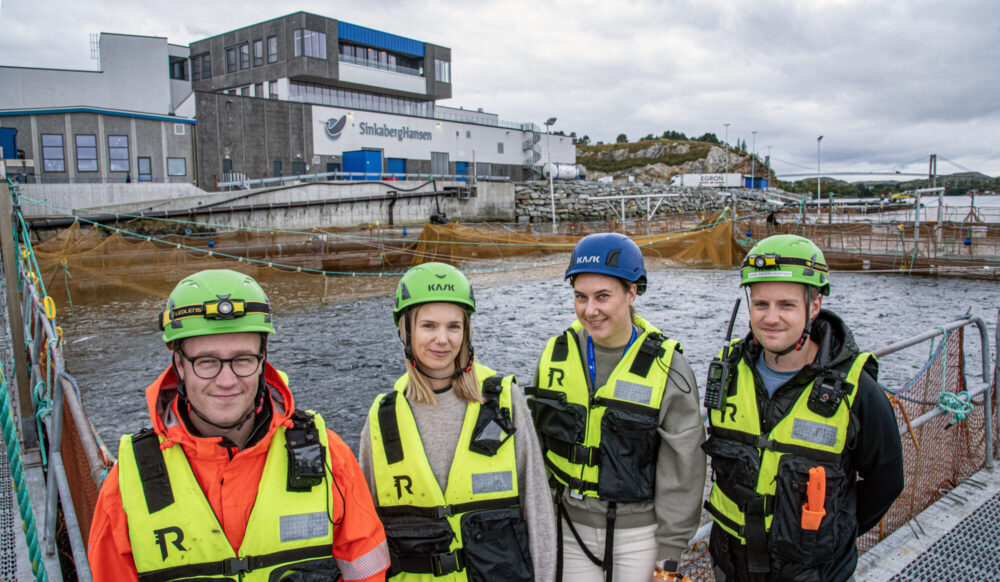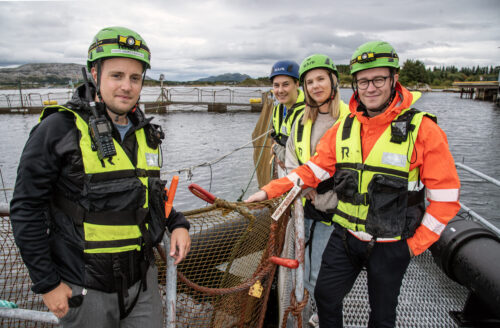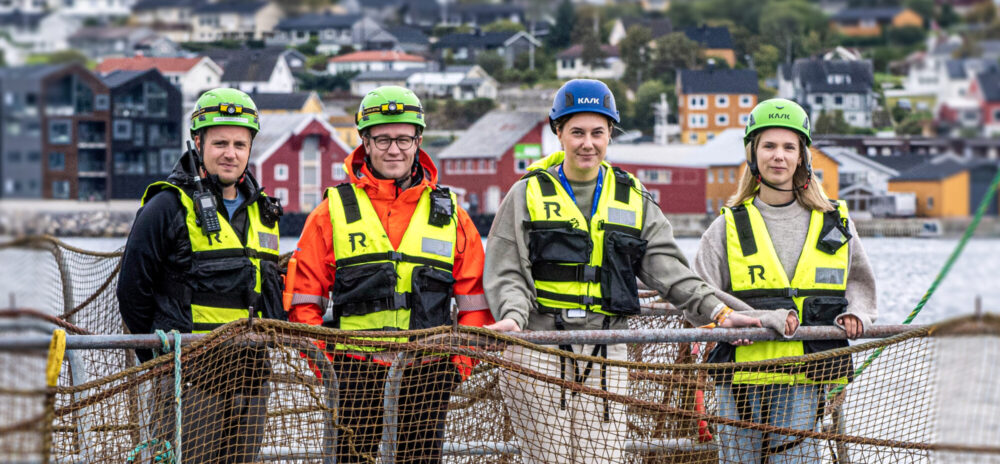Three 27-year-olds work here, alongside a manager who is an “old man” of 29. This young quartet shoulders significant responsibility as they manage fish health during the sea phase of a complex value chain, from smolt to harvested fish, within the SinkabergHansen Group, which employs more than 330 people.
– I’m a little doubtful that everyone who knows where I work entirely understands the responsibility and the values that we help to safeguard, smiles the 27-year-old fish health biologist Camilla Valan Moen. In October 2023, SinkabergHansen had 14.7 million of its own fish in the sea.
In addition, the group’s two hatcheries have about the same number of individuals, from tiny fry to near-sea-ready smolt. These are owned by partner Emilsen Fisk and located at Svaberget, on either side of the county border between Trøndelag and Nordland.

HUGE RESPONSIBILITY: These four are responsible for fish health during the sea phase at SinkabergHansen. From left to right: Jakob Mo, Eirin Ottesen, Camilla Valan Moen, and Daniel Engen Lauritzen. Here they are outside the salmon factory at Marøya in Nærøysund.
Since starting on July 1, Camilla has gained considerable insight. She came to SinkabergHansen with years of field experience from other regional aquaculture companies. The team spends a significant amount of time at sea, working closely with the site managers and operations technicians.
SinkabergHansen operates 13 facilities along the Namdal coast and up to Herøy in Nordland, typically housing more than a million salmon in each facility. Marøya, home to Laksefabrikken, is set to harvest and process around 85,000 tonnes of fish this year. This means that other operators and partners also send fish ready for slaughter to Marøya for processing and worldwide distribution to recipients.

YOUNG PEOPLE: The average age of the fish health team at SinkabergHansen is under 28. Pictured here are four people in charge: Camilla Valan Moen (left), Eirin Ottesen, Jakob Mo, and Daniel Engen Lauritzen.
Biology and welfare at the core
With a projected turnover of around NOK 3 billion this year, SinkabergHansen is the largest private company in Nærøysund in terms of food production, turnover, and number of direct employees.
Monitoring the complex biological production is crucial in a value chain involving over 40 different professions. This includes overseeing the entire two-year process from hatchery fish on land to the extensive growth phase in the sea. The company is at the forefront of developing new technology and methods. At SinkabergHansen, in particular, much of the salmon is kept at depth – i.e. in submerged cages, where specific solutions supply the fish with necessary air and feed.
» Salmon in the depths “lure” the lice
“Deep sea farming” addresses the industry’s biggest biological challenge: salmon lice. SinkabergHansen has been a leader in developing this type of operation for many years, continually advancing animal welfare and biology practices.
“Closer to the fish”
Fish veterinarian Jakob Mo (27) relishes the challenges and responsibilities at SinkabergHansen. One initiative involves appointing a “GP” for each site for systematic follow-ups.
– “Closer to the fish” is our guiding principle. It applies not only to the fish health team but to the entire group. It’s about raising awareness and bringing everyone closer to what we do. Thorough preparations and risk assessments lead to better results, including reduced mortality and ensuring fish health until slaughter, says Jakob.
Fish health biologist Eirin Ottesen (27), who joined SinkabergHansen on August 1, came from Val R&D, a local secondary school in Nærøysund with a strong focus on aquaculture education and related research and development.
» It is important to see the fish as an individual
– I appreciate how the company invests significantly in fish health and development. We’re being heard, and the path from decision to action is short. Viewing fish as individuals rather than a large, uniform group is crucial. The term “biomass” is mostly about quantity and economics, but our work is far more nuanced, Eirin explains.
All four team members spend considerable time in the field, gaining valuable experience and feedback. SinkabergHansen employs nearly 90 people in the aquaculture department, ranging from seasoned veterans to eager apprentices who want to invest in the industry.

“GP”: SbH has appointed a “general practitioner” for each site for methodical follow-up. In the photo, group manager of fish health Daniel Engen Lauritzen (left) is working with Camilla Valan Moen, Eirin Ottesen, and Jakob Mo.
Survival as the first commandment
A key goal for SinkabergHansen is achieving a 95 % survival rate during the sea phase. Recent results have been promising, but the team knows that good results do not come alone.
– Production involves many factors, but the fish’s strength at release is critical. The smolt company plays a crucial role in this, and our close dialogue with them is paramount. Negative developments often link to release conditions, so Jakob believes being as close as possible to biology at this stage is crucial,” says Daniel.
On 1 July, 29-year-old Daniel Engen Lauritzen took over as group manager of fish health. The fish health biologist with practical experience from independent businesses in northern Norway moved to the Namdal Coast almost three years ago.
» There is no shortage of challenges
– The time at SinkabergHansen has been incredibly inspiring. In all departments, we have taken the conscious relationship with fish health many steps further. While we are energized by progress, we face ongoing challenges, Daniel acknowledges.
“Knowledge brings change”
The manager is humble about the trust and responsibility given to him and his team in the fish health department. While the department is well underway with various processes, something is always happening.
Though much of their work is internal, positive actions are also being taken towards management and the broader industry. With the scale of our food production, managing all the information and knowledge collected by the industry will be a core task. There is great potential in evaluating and adjusting procedures. Knowing what works and then distributing tasks and responsibilities to everyone following the salmon from start to finish will determine a lot about Norwegian aquaculture in the future, believes the young group manager for fish health.
» Great potential in learning from collected data

